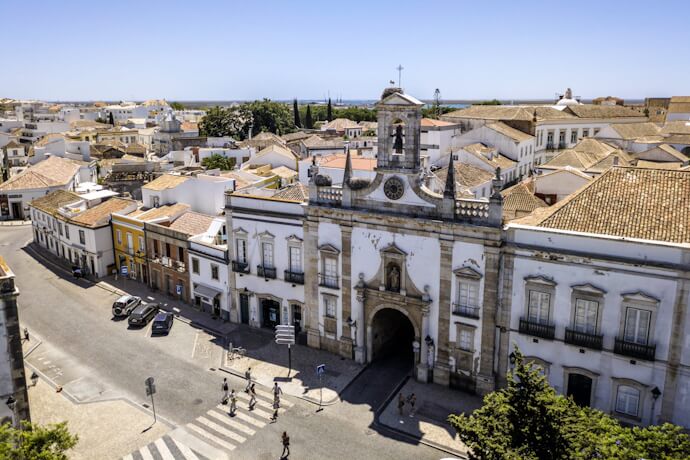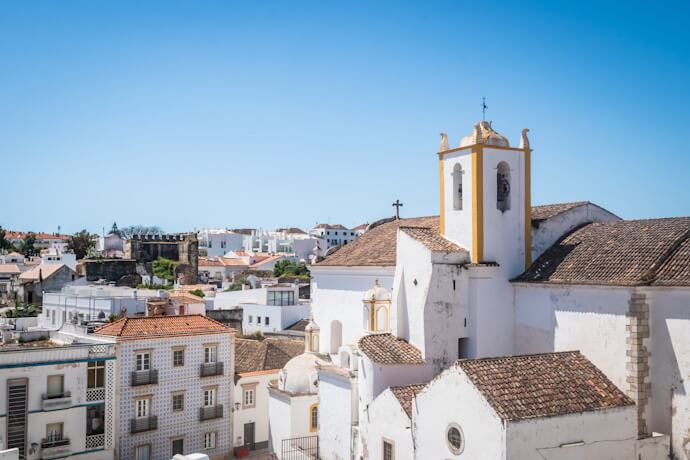When one envisions the Algarve, sun-drenched beaches and azure waves often spring to mind. Yet, beyond its coastal allure lies a tapestry of centuries-old stone, echoing with tales of knights, conquerors, and craftsmen. This hidden dimension of southern Portugal beckons travelers to wander through narrow alleys where Gothic arches jut skyward and ancient ramparts whisper secrets of bygone eras. Here, red sandstone fortresses guard hilltops, and medieval town centers reveal layers of Moorish and Christian influences.
Rather than merely lounging by the ocean, history lovers can trace the footsteps of past civilizations, unearthing a side of the Algarve few expect. Prepare to discover the unexpected soul of southern Portugal.
Silves
Once the magnificent capital of the Moorish kingdom in the Algarve, Silves still exudes an air of grandeur and historical weight. Dominating the town's skyline is the formidable Silves Castle its red sandstone walls glowing warmly in the afternoon light. Constructed in the 11th century, this castle once served as the political and administrative heart of the Muslim Taifa of Silves. Today, its intact battlements, towers, and cisterns allow visitors to imagine life as it was under the Almohads and Almoravids.
Just a short stroll from the castle stands the Sé Cathedral of Silves. Built on the site of a former mosque, this impressive structure is a powerful symbol of the Christian Reconquista. Its imposing Gothic arches, vaulted ceilings, and the medieval tombs of crusading knights create a solemn atmosphere, inviting quiet contemplation of the town's layered and often turbulent history. Exploring Silves is to step back into a pivotal era of the Algarve's past.
Loulé
Loulé offers a captivating glimpse into the Algarve's medieval heart, where remnants of its past are woven into the fabric of daily life. The town's most striking feature is the Church of São Clemente, a beautiful example of Gothic architecture. Its bell tower, however, tells an older story. It was once a minaret of the mosque that stood on this site, a clear symbol of the region’s transition from Moorish to Christian rule.
Wander through the charming old streets and you will discover sections of the original medieval town walls, which once encircled and protected this bustling market town. Strolling these cobblestone streets, one encounters quaint squares where artisans continue centuries-old crafts, creating leatherwork, ceramics, and filigree jewelry. The juxtaposition of Gothic church spires against fortified ruins conjures an image of medieval Loulé as both a spiritual sanctuary and a defensive stronghold. Here, history is not confined to museum cases but lives on in the rhythm of daily life.
Faro

Though often dismissed as merely a gateway to the Algarve’s beaches, Faro’s historic core brims with medieval charm. At its heart stands the Sé Cathedral, which began as a 13th-century Gothic structure before receiving Renaissance embellishments in the 16th century. Its ribbed vaults and pointed arches mingle seamlessly with classical pilasters and elegant portals. Climbing the cathedral’s tower rewards you with panoramic views of the Ria Formosa and the city’s terracotta rooftops. Nearby, the twin gates of Arco da Vila and Arco do Repouso once formed part of Faro’s fortified walls. These stone archways, adorned with religious sculptures, welcomed travelers into the walled city, with narrow alleyways leading past centuries-old palaces and ornate fountains.
As dusk falls, lantern-lit lanterns cast long shadows on the cobbles, evoking images of medieval merchants and pilgrims passing through these very portals. Faro’s hidden Gothic and Renaissance heart invites exploration beyond its sun-drenched façade.
Castro Marim
Perched majestically overlooking the serene marshlands of the Guadiana River, which forms the border with Spain, Castro Marim is a town defined by its strategic importance and its powerful fortifications. The landscape is dominated by two opposing fortresses. The medieval Castro Marim Castle, with origins tracing back to the Moors, was later the first headquarters of the Knights Templar in Portugal. Its weathered walls command impressive views and whisper tales of border skirmishes and legendary knights. Across the valley stands the 17th-century Fort of São Sebastião, a star-shaped fortification built to defend against Spanish incursions.
The historic town itself, nestled between these two giants, retains a traditional layout, its white-washed houses a stark contrast to the rugged stone of the castles. Castro Marim’s blend of medieval and later military architecture offers a vivid lesson in Portugal’s borderland past.
Aljezur

In stark contrast to the Algarve’s sunbaked sands, Aljezur’s verdant hills cradle a castle of Moorish origin, modest yet evocative. Castle of Aljezur, perched on a granite outcrop, dates to the 10th–12th centuries and once guarded Muslim settlements. Although only ruins remain, fragments of its defensive walls and the outline of its keep still point skyward, guiding your imagination back to a time of desert caravans and Andalusian courts. From this vantage, one gazes upon rolling hills dotted with olive groves and cork oaks, while in the distance, the roaring Atlantic hints at the contrast between land and sea.
Wandering through Aljezur’s medieval street plan, narrow lanes curve unpredictably, testimony to organic growth rather than planned expansions. Whitewashed homes with shuttered windows nestle close together, and every bend seems to reveal a shaded plaza or a hidden chapel. Here, the Algarve feels less touristic and more intimate, drawing you into a tranquil, centuries-old world.
Tavira

Often considered one of the most beautiful towns in the Algarve, Tavira is a romantic tapestry of cobbled lanes, historic bridges, and graceful architecture. Its medieval past is proudly displayed in the heart of the town. The ruins of Tavira Castle offer a tranquil garden within their walls and provide a picturesque viewpoint over the town’s iconic pyramid-style roofs and the Gilão River.
Adjacent to the castle stands the Church of Santa Maria do Castelo, a church with proud Gothic origins built on the site of a mosque. It houses the tombs of seven Christian knights who died recapturing the town from the Moors. The so-called ‘Roman Bridge’, which is actually medieval in origin, elegantly spans the river and connects the two sides of this charming town, inviting unhurried strolls and quiet moments of reflection. Every balcony and shutter seems to whisper of artisans, fishermen, potters and goldsmiths, who have made Tavira their home for centuries.
Lagos

Lagos, a town inextricably linked with Portugal's Golden Age of Discovery, also boasts an impressive medieval heritage. The town is still partially enclosed by its robust 14th-century walls, which stood strong against pirate attacks and foreign invaders. These defensive structures, along with the Ponta da Bandeira fort, protected the harbour from which many of Henry the Navigator's expeditions departed. Within these walls, the Church of Santa Maria de Lagos, with its origins in the 15th century, stands as a testament to the town's long-standing faith and maritime importance.
The nearby Church of Santo António, though more baroque in its dazzling gilded interior, is another key historical landmark. Exploring the old town reveals a place where the grandeur of the Age of Discovery meets the resilience of its medieval foundations. Wandering its narrow alleys, one can almost hear the creak of wooden ships and the prayers of pilgrims seeking blessings for their journeys.
Embracing the Algarve’s Timeless Heritage
As you have journeyed with us through time, it's clear that the Algarve's story extends beyond its golden sands, embracing the enduring stone of its castles, the sacred silence of its churches, and the ancient layouts of its towns. This region invites you to discover a new layer of history with every inland adventure. We invite you to balance days by the sea with explorations of these timeless treasures. If you yearn for history’s whispers and the thrill of discovery, let TourTailors guide you off the beaten path, where the Algarve’s unexpected past awaits!







